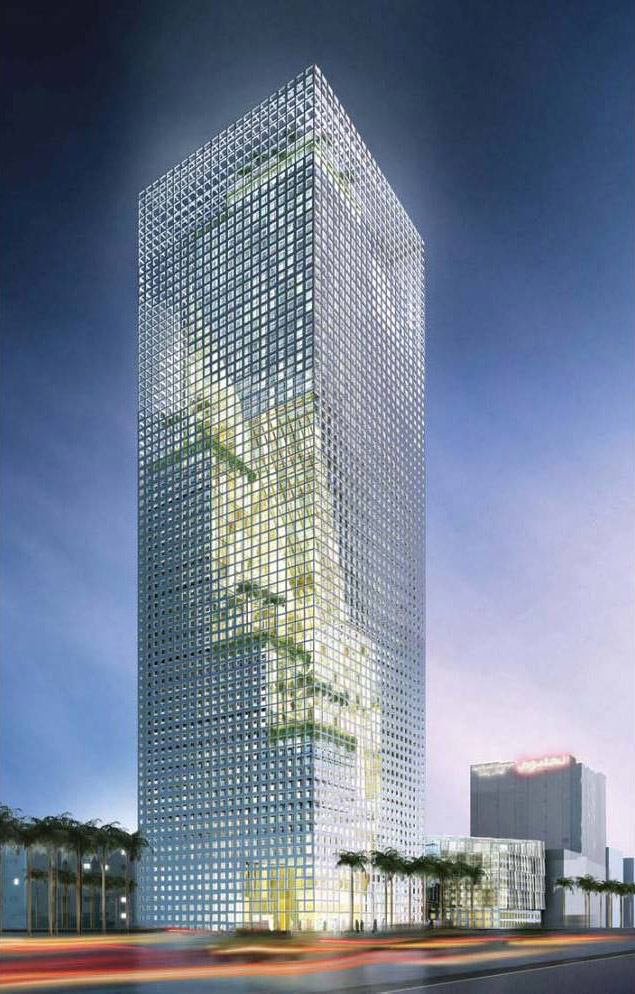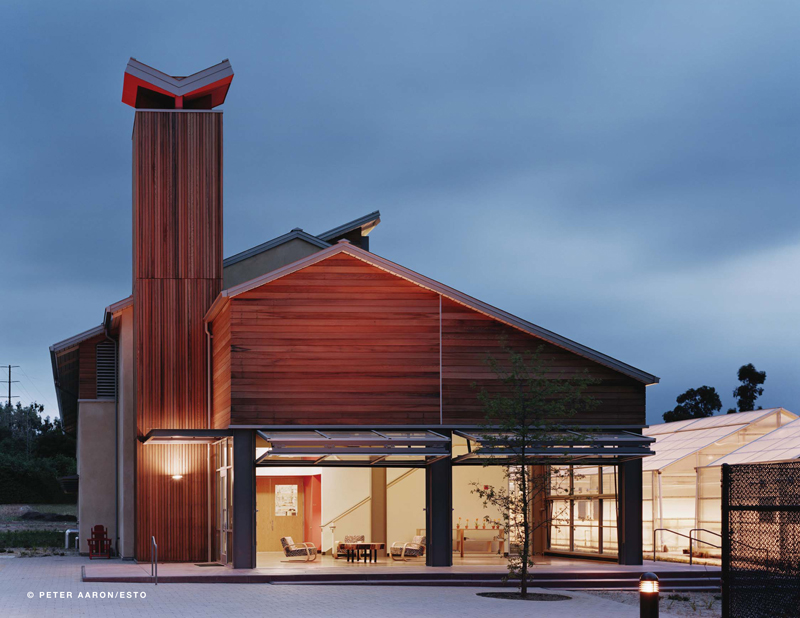|
|
 Image 1. A night view of the design showing the shading envelope and the spiraling forms behind. Copyrights: Perkins+Will In February 2010, the design for Al-Birr Foundation Headquarters in Riyadh, Saudi Arabia, has been named as the winner of the 2010 Architectural Review / MIPIM Future Projects Awards under the ‘tall buildings’ category (Image 1). The unbuilt project, designed by Perkins+Will’s New York Office, was commissioned for Al-Birr Foundation, a non-profit organization aimed at alleviating poverty and caring for disadvantaged families and children.
The Design
Of the many features of the design of the 59, 000 sqm tower, perhaps the most interesting is how it was concieved as a sustainable urban tower that responds to the environmental characteristics and the microclimate of the city of Riyadh, which is a challenging climate to address given the extreme solar exposure and the heat conditions of Riyadh.
Faced with these climatic conditions and a deep plot of 1000 x 1200m, the projects’s designers response was to rethink the high rise typology in this context. The design’s most visible response to the climate is the building’s envelope which was designed as a large rectangular frame of brise-soleil enclosing the occupied parts of the building. This shading frame was designed to respond to both the different amounts of solar radiation received by each elevation as well as the interior spaces behind it. To achieve this result, a mapped shading mesh was devised to provide varying levels of openness for different locations of the different elevations depending on its solar exposure and its spatial/contextual influences. The result was an envelope that resembles a mesh of varying densities surrounding the building and simultaneously protecting and revealing the activities behind it.
This proposed design solution thus helps the building reduce its solar heat gain while maintaining its views towards the city (FIgure 1). In addition to this shading effect, the mesh-like dynamic treatment of the envelope has also helped animate the building’s expression with the dense and sparse zones of the facade adding a dynamic effect to what otherwise may have become a static pure form.
Continue reading Riyadh Tower Design adapts a Traditional Middle Eastern Shading Strategy
Karim Elgendy
The Carnegie Center for Global Ecology in Stanford is a research facility that combines Laboratories and office spaces. The 1100 Sqm building was built on a previously developed plot of 7.4 acres. The client’s main concerns were lowering the carbon emissions tied to the building’s energy use as well as the embodied carbon emissions of building materials. Flexibility over the short and long term was also of utmost importance to the client who wanted to allow for the expansion and contraction of research teams.Like Many of the Climates of the Middle East, Stanford has an arid climate with a long dry summer season, and benefits from northwest breezes.
 Image 1. View of the Eastern facade of the Carnegie Center showing the wind tower and the naturally ventilated entrance lobby. Copyright: Peter Aaron / Esto
Karim Elgendy
Energy use in buildings accounts globally for nearly 40% of global energy consumption and 36% of total energy-related carbon dioxide emissions. These percentages are almost equally split in two halves between the industrialized countries and the rest of the world (Price et al., 2005).
Our buildings use energy in two ways; first, to keep our interior environment comfortable through cooling, ventilation, and heating our spaces; second, to power the appliances that we have come to depend on such as home appliances, lighting systems,computers, and other office equipments. To reduce this high percentage of energy use and the resultant carbon dioxide emissions, both sources of energy use in buildings must be addressed. The first energy use can be addressed by improving the building envelope’s efficiency in order to reduce the need to condition its spaces (cooling, heating, and ventilating). This method of conserving energy use includes a vast array of passive low energy design strategies that depend on the building’s environment and context. The second energy use can be addressed by improving the efficiency of appliances and equipment used inside buildings including improving the efficiency of lighting and dissemination of improved stoves for cooking in rural areas. Continue reading The State of Energy Efficiency Policies in Middle East Buildings
Karim Elgendy
A pan-Arab survey conducted by the Arab Forum for Environment and Development (AFED) found that a resounding majority of 98% believed that the climate is changing.
The survey sample which included a big segment of educated people (who more reflect the views of those nearer to decision making, than proportionally reflect the actual population mix) showed that only a small portion of 5% said they did not understand what climate change was, reaching a maximum of 11% in Syria. However, 95% of those who said they did not understand what climate change was, still answered that they believed the weather was changing, (Figure 1). A majority of 89% also thought that this change was due to human activities, including excessive use of energy and depletion of resources, (Figure 2). These results clearly showed that climate change has become widely accepted by the public in Arab countries as a fact which needs to be addressed. Moreover, the survey showed that the skeptical attitudes which prevailed among some groups on the facts and causes of climate change, either denying it entirely or limiting it to natural causes, are decreasing.
 Survey Figure 1. Source: AFED Arab Environment Climate Change Report. Continue reading The Arab World’s Opinion on Climate Change
 Masdar City Masterplan. Copyright Masdar, Foster+Partners When Masdar City was first announced in 2007 by the Masdar Initiative, it claims that, when completed, it will become the world’s first zero carbon, zero waste development, while maintaining the highest quality of living. Foster + Partners and a team of environmental consultants including WSP and Transsolar have been appointed by Masdar to design the masterplan and the first stage of the project which broke ground in February 2008.
Masdar City’s Master plan is claimed to “meet and exceed” the principals of One Planet Living (OPL), a set of ten guiding principles of sustainability, proposed in a joint initiative by WWF, the global conservation organization and Bioregional Development, whereby everyone lives within their fair share of the Earth’s resources. The principles include Zero Carbon, Zero Waste, Sustainable transport, Sustainable materials, Sustainable water, and Sustainable culture and heritage.
The project also comes in the context of a rapidly increasing population and an economic boom in Abu Dhabi which -, together with new laws opening the emirate’s real estate to the free market- led to speculation and a housing shortage estimated in 2008 to between 35,000 and 50,000 dwelling units. This shortage has prompted the state to allocate billions for the construction of residential buildings, especially for foreign workers and western expatriates. This housing shortage has also resulted in rising house prices, which led to discussion of legislations that would introduce a 20 per cent quota for low-income housing in future developments.
Continue reading Masdar City Masterplan Reviewed
|
|




